My vivacious friend Nina is an Israeli American whose family was originally from Romania. Her husband is originally from Iraq. As a result, Nina knows how to make all of the most amazing Israeli, Iraqi, Romanian, and Sephardic dishes.
Nina’s recipes are in her head, from a lifetime of cooking seven days a week. I had this idea to get together, cook, and write down instructions in English along with measurements, so I could make her recipes accessible to the average home cook. We set aside a day from 9 a.m. until 2p.m.
We made Green Bean and Tomato Stew with Beef, Beef Koubideh Kabob, savory Mushroom Borekas with puff pastry and Okra Stew. These dishes brought back food memories from childhood, spicy without too much heat, lots of tomatoes, lots of stuffed things, lots of vegetables. Sephardic comfort food. Serve them with white basmati rice or other rice pilaf.
Okra unfortunately, gets a bad rap because when it is prepared incorrectly it can have a slimy consistency. Following my instructions will fix the problem and okra is delicious. When you trim the okra be sure not to nick the body of the okra or trim the stem too close. If the okra are intact they don’t ooze.
The dumplings are made with farina, a cereal available in brown organic or white refined. Both the stew and the dumplings call for Baharat, a blend of spices used in Turkish and Iraqi cuisine. It is available in Israeli or Middle Eastern markets in bulk or small bottles. Aslo see http://www.penzys.com/cgi-bin/penzeys/shoptom.html or http://kalustyans.com/default.asp. Also I recommend using non-latex, non powdered disposable gloves when working with raw meat or poultry.
12 ounces fresh or frozen okra
1 ½ cup diced yellow onion
3 tablespoons olive oil
4 Roma tomatoes, grated
2 teaspoons sugar
½ cup fresh lemon juice
2 teaspoons Baharat* seasoning
1 teaspoon sweet paprika
½ teaspoon salt
½ teaspoon fresh cracked pepper
1 fourteen ounce can chopped tomatoes with added puree
Kooba Filling
1 pound ground beef
½ cup minced yellow onion
2/3 cup minced parsley
¼ teaspoon salt
½ teaspoon pepper
2 teaspoon paprika
1 teaspoon chili powder
2 teaspoon Baharat seasoning
2 tablespoons safflower oil
Kooba shell
2 cups farina*
1 ½ cups water
½ teaspoon salt
bowl of water
If you are using fresh okra, wash them and trim the tips. Be careful not to nick them or a slimy ooze will start to seep out. Heat a Dutch oven over medium heat. Add the olive oil and the chopped onions. Sauté the onions until sweet and translucent but not colored, about 5 minutes. Add the okra and sauté until bright green, about 4 minutes. Next, add the grated tomatoes, stir until bubbling, and cover the pan for a few moments. Remove the lid and add the sugar, lemon juice, baharat, paprika, salt, and pepper. Add the canned tomatoes. Cover, leaving lid ajar, and reduce the temperature to low. Let the okra simmer slowly for about 20 minutes, while you prepare the kooba. The sauce should concentrate and reduce while the flavors develop.
Combine the ground beef, onion, parsley, salt, pepper, paprika, chili powder, baharat, and oil in a medium bowl, using your gloved hands to incorporate well.
Make the shells by first combining the farina, salt, and water in a bowl. The batter should be soft. Wet your hands in a small bowl of water. Divide the farina batter into approximately 22 balls. Wet your hands again and place a ball in the palm of your left hand. Roll the ball to make it very smooth. With your moistened index and middle finger of your right hand, flatten the ball into a thin circle, covering your palm, around 2 1/2 inches in diameter. Place a full teaspoon full of filling in the center of the circle. Cup your hand to bring up the sides and using your moistened right index finger and thumb close the kooba. Smooth the seal and set the kooba on a wet plate.
When you have prepared all the kooba, open up the Dutch oven, with the simmering okra, and gently place the kooba in a circle around the perimeter of the pan and then in the center. Cover the pot and gently simmer for another 1 1/2 hours.
You might have raw leftover kooba that did not fit in the dutch oven. These can be frozen single layer, in a container with a little water in the bottom and added to any soup you like or use the next time you make the Bamya.
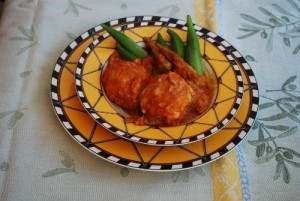
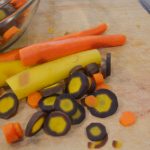
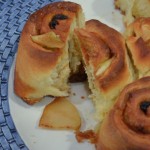
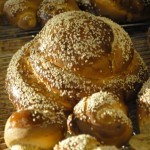
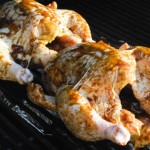
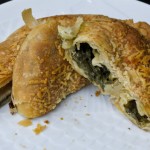

Leave a Reply